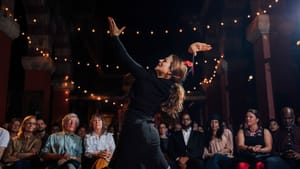Stay in the Loop
BSR publishes on a weekly schedule, with an email newsletter every Wednesday and Thursday morning. There’s no paywall, and subscribing is always free.
Welcome to flamenco
Artsi and Pasion y Arte present ‘The Voices of Women in Flamenco’

As a young nonprofit, Artsi combines the arts with nontraditional (read: more accessible) spaces to create, as cofounder Pradhan Sharma put it, “a mixture of the arts and nightlife.” This union blended seamlessly with tablao, the café-like performance atmosphere common to flamenco dance, and Fleisher Art Memorial’s galleries and churchlike hall made for a scintillating mix of sacred and mundane.
Ascent and eruption
I’ve seen very little flamenco before, and this was my first time seeing Elba Hevia y Vaca’s all-women flamenco company, Pasion y Arte. (Hevia y Vaca is an adjunct professor at my alma mater, Franklin and Marshall College.) I was sliding into a pew when the first trio, two dancers and a guitar player, took to the dance floor, bookended by a few rows of chairs. (It’s worth noting that, in my quest for a seat in Fleisher’s church space, I missed a brief opening performance from Hevia y Vaca and her students in the gallery).
To my admittedly untrained eye, the flamenco presented a variety of dualities for the dancers to wield at whim: strong and soft, swift and slinking, vulnerable and voracious. The slower moments in the series of duets and trios that followed were not moments of pause or rest but felt weighted with tension and anticipation, like the slow ascent up the slope of a rollercoaster.
While the dancers strode languidly about the floor, arms above with wrists circling floreo, their torsos remained taut and pulled upward. This bodily position, called colocación, illustrates the relationship between heaven and earth. After the buildup, they erupted in a flurry of precise and intricate footwork, arms gesticulating and heads held high, stomping wildly into the ground as the increasingly impassioned guitarist played louder and stronger. The performers (dancers, singers, and guitarists) moved seamlessly, thrillingly, between these two states.
A welcoming experience
As a dancer reached the end of her movement, she found her way back to her seat on the edge of the floor while the music and song kept on. I’m not sure if there was a preset order to the evening, but eventually another dancer would rise, not unlike one who feels called to share during a Quaker meeting.
There is certainly something about flamenco and the tablao form that feels ritualistic, religious even, and this effect was certainly heightened by the pews, soaring ceilings, and murals on the walls of the converted church. Yet there was simultaneously a wonderful casualness to it all. Audience members were free to change seats, grab another glass of wine, or react audibly during the performance. String lights hung above the dance floor while blue and pink stage lights lit the bar. There was no physical separation between performers and spectators; chairs and tables were placed in the round rather than proscenium-style. I believe there was a bachelorette party on the first stop of their evening sitting in front of me. The entire evening balanced the spiritual with the ordinary, living up to Artsi’s mission of culturally accessible experiences.
What, When, Where
The Voices of Women in Flamenco. Choreography by Elba Hevia y Vaca. Artsi and Pasion y Arte. April 19, 2019 at Fleisher Art Memorial, 719 Catharine Street, Philadelphia, PA. artsiphilly.org.
Sign up for our newsletter
All of the week's new articles, all in one place. Sign up for the free weekly BSR newsletters, and don't miss a conversation.

 Kat J. Sullivan
Kat J. Sullivan